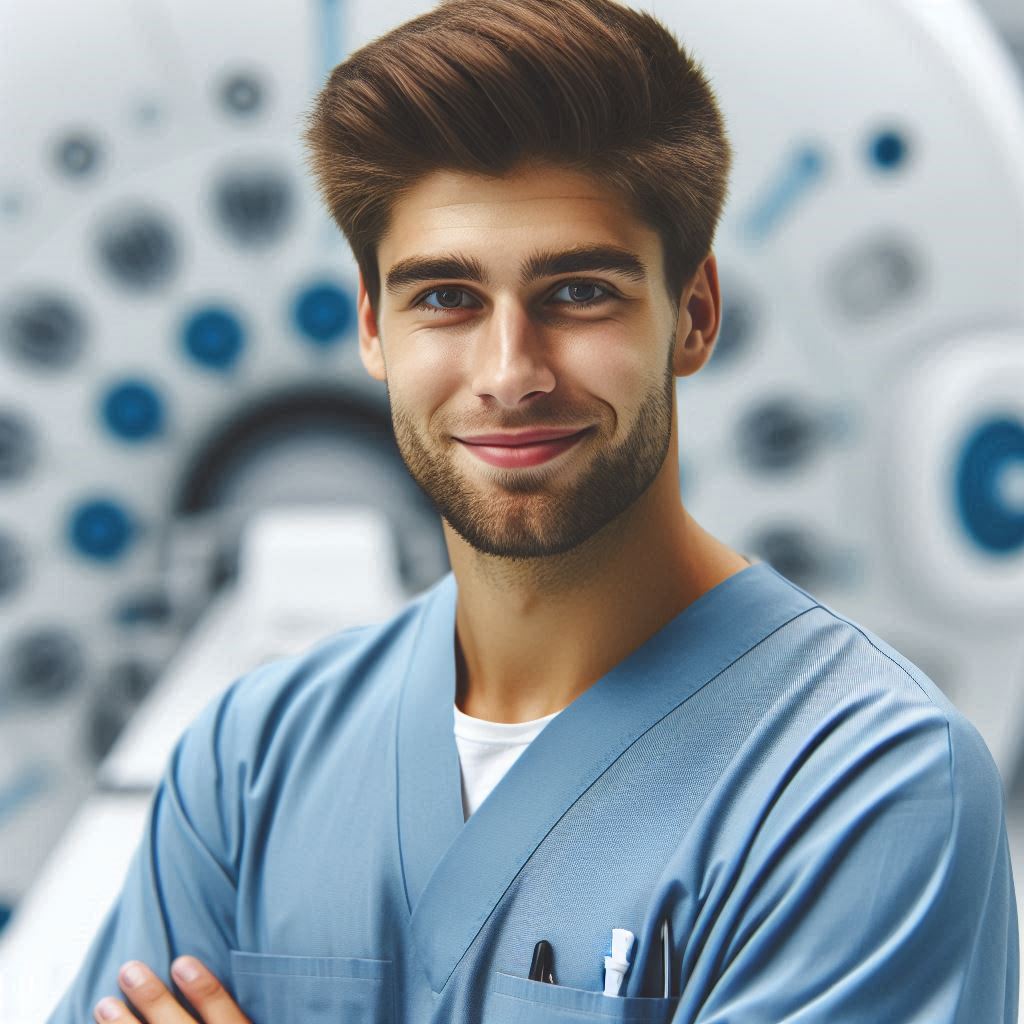Introduction
Sleep disorders are pervasive health conditions that disrupt crucial rest cycles, profoundly impacting overall health and well-being.
From insomnia to sleep apnea and restless legs syndrome, these disorders vary widely in their manifestations and severity, yet they all share the common effect of compromising sleep quality and daytime functioning.
Accurate diagnosis is paramount not only for understanding the underlying causes but also for tailoring effective treatment plans that address individual needs.
Technologists are integral to the diagnostic process, leveraging advanced monitoring and analysis techniques to assess sleep patterns with precision.
Through polysomnography and other specialized tests, they gather detailed data on sleep stages, breathing patterns, and physiological responses during sleep.
This meticulous approach ensures comprehensive evaluation, enabling healthcare professionals to make informed decisions about treatment strategies.
Moreover, technologists collaborate closely with clinicians to interpret findings and provide detailed reports that guide therapeutic interventions and ongoing management.
By bridging technological innovation with clinical expertise, technologists play a vital role in improving diagnostic accuracy and enhancing patient outcomes in the realm of sleep medicine.
Their contributions underscore the importance of a multidisciplinary approach to addressing sleep disorders, promoting better sleep health, and overall quality of life.
What is a sleep technologist?
A sleep technologist is a specialized healthcare professional who plays a crucial role in diagnosing and treating sleep disorders.
These professionals are trained to monitor and analyze patients’ sleep patterns using advanced equipment and technology.
They work closely with physicians and other healthcare providers to ensure accurate assessments and effective treatment plans for patients suffering from various sleep disorders.
Definition and Role of Sleep Technologists
Sleep technologists, also known as polysomnographic technologists, conduct sleep studies to evaluate patients’ sleep quality, breathing patterns, and brain activity during sleep.
They set up and calibrate monitoring equipment, apply electrodes and sensors to patients, and monitor their responses throughout the night.
By recording data on sleep stages, heart rate, and oxygen levels, technologists provide essential information that helps physicians diagnose conditions such as sleep apnea, narcolepsy, and insomnia.
Skills and Qualifications Required to Become a Sleep Technologist
Becoming a sleep technologist requires specialized training and certification.
Typically, technologists have backgrounds in healthcare or allied health fields, such as respiratory therapy or nursing.
They undergo formal education and clinical training in sleep medicine, learning to interpret sleep study results and recognize abnormal patterns indicative of sleep disorders.
Attention to detail, strong analytical skills, and proficiency in operating sleep monitoring equipment are essential for success in this role.
Importance of Sleep Technologists in the Healthcare Industry
Sleep technologists play a vital role in the healthcare industry by facilitating accurate diagnosis and treatment of sleep disorders.
Their expertise in conducting polysomnography and interpreting sleep data ensures that patients receive appropriate care tailored to their specific needs.
By collaborating closely with physicians and sleep specialists, technologists contribute to comprehensive patient care plans that aim to improve sleep quality, enhance daytime functioning, and prevent complications associated with untreated sleep disorders.
In addition to diagnostic duties, sleep technologists educate patients about sleep hygiene practices and the importance of adhering to prescribed treatments.
They monitor patients’ progress over time, adjusting treatment plans as necessary to optimize outcomes.
This proactive approach helps patients manage their sleep disorders effectively and promotes long-term health and well-being.
In review, sleep technologists are integral members of the healthcare team dedicated to improving sleep health and quality of life for individuals affected by sleep disorders.
Their specialized knowledge, technical skills, and commitment to patient care make them essential allies in the fight against the detrimental effects of inadequate sleep.
As awareness of sleep disorders grows, the role of sleep technologists continues to expand, ensuring that individuals receive the comprehensive care they need to achieve restorative sleep and lead healthier lives.
Common Sleep Disorders Diagnosed by Technologists
Insomnia
Insomnia is a common sleep disorder that affects millions of people worldwide.
Technologists play a crucial role in diagnosing this condition by monitoring the sleep patterns and identifying any disturbances that may be causing the inability to fall or stay asleep.
Insomnia symptoms vary, typically involving difficulty falling asleep, frequent nighttime awakenings, and waking tired or unrefreshed.
Technologists use specialized equipment to track sleep cycles and detect any abnormalities that may be contributing to these symptoms.
Technologists use polysomnography to diagnose insomnia, recording brain activity, eye movements, heart rate, oxygen levels, and muscle activity during sleep.
This comprehensive analysis provides valuable insights into the quality of sleep and helps identify potential issues that may be disrupting the sleep cycle.
Technologists assess daytime sleepiness and identify conditions like sleep apnea or narcolepsy using the Multiple Sleep Latency Test (MSLT).
By conducting these tests and interpreting the results, technologists provide essential information for developing effective insomnia treatment plans.
Sleep Apnea
Sleep apnea is a serious sleep disorder characterized by breathing interruptions during sleep.
Technologists play a critical role in diagnosing sleep apnea by monitoring respiratory patterns and identifying abnormal breathing events that may be impacting the quality of sleep.
There are two main types of sleep apnea: obstructive sleep apnea (OSA) and central sleep apnea (CSA). OSA occurs when the airway becomes blocked during sleep, leading to pauses in breathing and reduced oxygen levels.
CSA, on the other hand, involves a dysfunction in the brain’s respiratory control center, causing breathing cessation throughout the night.
Technologists utilize polysomnography to monitor respiratory efforts, airflow, and oxygen saturation levels during sleep to diagnose sleep apnea accurately.
This assessment identifies the frequency and duration of breathing pauses and associated symptoms like snoring or gasping.
In addition to polysomnography, technologists may recommend a home sleep apnea test (HSAT) for patients who prefer to undergo testing in the comfort of their own home.
This portable device measures breathing patterns and oxygen levels during sleep, aiding in diagnosing sleep apnea. It determines treatment options.
By collaborating with sleep specialists and interpreting test results, technologists can assist in developing a personalized treatment plan for patients with sleep apnea.
Treatment options may include CPAP therapy, oral appliances, lifestyle changes, or surgical interventions to improve breathing and sleep quality.
Restless Leg Syndrome
Restless leg syndrome (RLS) causes an irresistible urge to move the legs, accompanied by tingling, crawling, or aching sensations.
Technologists play a vital role in diagnosing RLS by monitoring leg movements during sleep and identifying any disruptions that may be contributing to the symptoms.
The symptoms of RLS typically worsen in the evening or at night, leading to difficulty falling asleep and frequent leg movements that can disrupt the sleep cycle.
Technologists use specialized equipment to record limb movements during sleep, assessing RLS severity by movement frequency and duration.
One of the main diagnostic tools used by technologists to evaluate RLS is actigraphy, which measures limb movements and restlessness during sleep.
This data identifies abnormal leg movements or kicking episodes indicating RLS, guiding healthcare providers in treatment planning.
In addition to actigraphy, technologists may recommend a sleep diary or questionnaire to gather information about the patient’s sleep habits, symptoms, and daily routines.
Technologists combine objective data with subjective reports to assess RLS comprehensively and recommend effective symptom alleviation strategies.
Transform Your Career Today
Unlock a personalized career strategy that drives real results. Get tailored advice and a roadmap designed just for you.
Start NowNarcolepsy
Narcolepsy is a chronic neurological disorder characterized by excessive daytime sleepiness, sudden loss of muscle control, and hallucinations during sleep.
Technologists play a crucial role in diagnosing narcolepsy by monitoring sleep patterns and identifying the symptoms that may be indicative of the disorder.
Excessive daytime sleepiness is a hallmark symptom of narcolepsy, characterized by sudden drowsiness episodes or strong nap urges.
Technologists use polysomnography and the Multiple Sleep Latency Test (MSLT) to evaluate daytime sleepiness and assess sleep onset.
In addition to daytime sleepiness, patients with narcolepsy may experience cataplexy, a sudden loss of muscle tone triggered by strong emotions like laughter, anger, or excitement.
Technologists monitor muscle activity and REM sleep patterns during polysomnography to identify any signs of cataplexy and confirm the diagnosis of narcolepsy.
Other symptoms of narcolepsy may include sleep paralysis, hallucinations, and disrupted nighttime sleep.
Technologists collaborate closely with sleep specialists to interpret test results, evaluate narcolepsy symptoms’ severity, and recommend effective treatments.
Parasomnias
Parasomnias are a group of sleep disorders characterized by abnormal behaviors or movements during sleep, such as sleepwalking, nightmares, or night terrors.
Technologists play a vital role in diagnosing parasomnias by monitoring sleep patterns and identifying any disruptions that may be contributing to these abnormal sleep behaviors.
One of the most common parasomnias is sleepwalking, which involves getting out of bed and walking around while still asleep.
Technologists use polysomnography to record brain activity and muscle movements, identifying sleep stages and factors triggering sleepwalking episodes.
Nightmares and night terrors are other types of parasomnias that can disrupt sleep and cause distress for individuals.
Technologists use specialized equipment to monitor heart rate, breathing patterns, and brain activity during REM sleep to identify abnormal responses.
In addition to monitoring sleep patterns, technologists recommend using a sleep diary or questionnaire for gathering parasomnia episode details.
Technologists combine objective data with patient reports to assess parasomnias and collaborate with healthcare providers to create tailored treatment plans.
Therefore, sleep technologists vitalize diagnosing and treating various sleep disorders like insomnia, apnea, restless leg syndrome, narcolepsy, and parasomnias.
Technologists use advanced tools and interpret results to uncover causes and help develop personalized treatment plans for better sleep quality.
Read: Advancement Opportunities for Surgical Technologists
Tools and technologies used by sleep technologists
Diagnosing sleep disorders relies heavily on advanced tools and technology operated by skilled sleep technologists.
These professionals utilize a range of specialized equipment to accurately assess and diagnose various sleep-related conditions.
They employ tools such as Polysomnography (PSG) equipment, Actigraphy devices, Multiple Sleep Latency Test (MSLT), and CPAP machines.
Each plays a crucial role in different aspects of sleep disorder diagnosis and management, ensuring that patients receive appropriate treatment tailored to their specific needs.
Polysomnography (PSG) Equipment
PSG is a cornerstone in sleep diagnostics, capturing comprehensive data during sleep.
It records brain waves, eye movements, muscle activity, heart rhythm, and breathing patterns to detect sleep-related disorders like apnea.
PSG equipment includes electrodes placed on the scalp and face, which monitor and record physiological changes throughout the night.
Technologists meticulously analyze these recordings, providing detailed insights into a patient’s sleep architecture and identifying disturbances.
Actigraphy Devices
Actigraphy devices are worn like wristwatches and monitor activity levels and sleep-wake patterns over extended periods.
This non-invasive method provides valuable information on circadian rhythm disorders, such as shift work sleep disorder or delayed sleep phase disorder.
Actigraphy tracks movements and light exposure, helping sleep technologists assess sleep patterns outside the lab, providing holistic insights.
Multiple Sleep Latency Test (MSLT)
MSLT measures how quickly a person falls asleep during the day and is crucial in diagnosing disorders such as narcolepsy.
Technologists administer timed naps during the day after an overnight PSG to evaluate and diagnose excessive daytime sleepiness.
This test differentiates between narcolepsy and other causes of daytime sleepiness, guiding clinicians in tailoring effective treatment strategies.
Continuous Positive Airway Pressure (CPAP) Machines
CPAP machines are essential in the treatment of obstructive sleep apnea (OSA), a common sleep disorder characterized by repetitive pauses in breathing during sleep.
These devices deliver pressurized air through a mask worn over the nose or mouth, keeping the airway open and preventing airway collapse.
Sleep technologists set up and monitor CPAP devices, adjusting settings based on PSG findings to optimize treatment efficacy.
They ensure patient comfort and compliance.
Importance of Accurate and Reliable Equipment
The use of accurate and reliable equipment is paramount in diagnosing sleep disorders correctly.
Reliable data ensures accurate interpretation and appropriate treatment planning, which is crucial for enhancing patient outcomes and improving their quality of life.
Technologists receive extensive training to operate and interpret these tools effectively.
They provide precise diagnoses and personalized treatment recommendations for each patient.
Advancements in technology continue to refine diagnostic capabilities, enhancing the precision and efficiency of sleep disorder assessments.
Portable actigraphy devices and sophisticated PSG systems empower sleep technologists to uncover hidden sleep disturbances and improve health outcomes.
By leveraging advanced equipment and their expertise, sleep technologists play a crucial role in promoting better sleep health and quality of life for patients worldwide.
They use state-of-the-art tools to ensure individuals with sleep disorders receive comprehensive care for restful, rejuvenating sleep.
Read: Preparing for a Sonography Job Interview: Tips

Uncover the Details: Interview Tips for Aspiring Rehabilitation Counselors
Showcase Your Business Today
Reach thousands of readers actively exploring professional services. Publish your business profile and grow your audience now.
Publish NowProcess of Diagnosing Sleep Disorders
Diagnosing sleep disorders is a multifaceted process that involves several crucial steps to ensure accurate assessment and effective treatment planning.
It begins with a comprehensive patient assessment, where sleep technologists gather detailed medical history and information about symptoms and sleep patterns.
This initial evaluation helps identify potential underlying causes of sleep disturbances and informs the approach to further diagnostic tests.
Patient Assessment and Medical History
Sleep technologists conduct thorough interviews with patients to understand their sleep habits, medical conditions, and lifestyle factors that may impact sleep quality.
This information provides valuable insights into the patient’s overall health and helps in determining the appropriate diagnostic tests needed.
During this assessment, technologists consider medications, stress levels, and environmental factors to understand the patient’s sleep challenges comprehensively.
Setting Up and Monitoring Sleep Studies
During sleep studies, technologists set up specialized equipment to monitor various physiological parameters during sleep.
This includes attaching electrodes and sensors to measure brain waves, eye movements, muscle activity, heart rate, and breathing patterns throughout the night.
Continuous monitoring ensures that accurate data is collected to assess sleep stages and detect any abnormalities indicative of sleep disorders.
Technologists meticulously calibrate and adjust equipment to ensure optimal recording quality, allowing for detailed analysis post-study.
Analyzing and Interpreting Sleep Data
After completing the sleep study, technologists meticulously analyze the collected data to identify patterns and abnormalities in sleep architecture and respiratory events.
They use specialized software to generate detailed reports that highlight key findings and assist physicians in making accurate diagnoses.
This analysis is crucial in determining the presence and severity of conditions such as sleep apnea, insomnia, and restless legs syndrome.
Technologists may also perform manual scoring of sleep stages and events to supplement automated analyses, ensuring comprehensive evaluation.
Collaborating with Healthcare Providers to Develop Treatment Plans
Technologists closely collaborate with sleep specialists, pulmonologists, neurologists, and other healthcare providers to develop personalized treatment plans.
This approach ensures treatment recommendations align with the patient’s specific needs and medical history, effectively managing sleep disorders.
Based on their expertise in sleep data interpretation, technologists provide critical insights for tailored therapeutic strategies.
These strategies may include lifestyle modifications, CPAP therapy, or medication.
Ensuring Patient Comfort and Safety During Sleep Studies
Throughout the sleep study, technologists prioritize patient comfort and safety, monitoring equipment and addressing patient concerns promptly.
They maintain a tranquil environment conducive to natural sleep patterns, ensuring that the data collected accurately reflects the patient’s typical sleep behavior.
Technologists educate patients on the sleep study process, addressing anxieties and emphasizing adherence to study protocols.
In essence, the process of diagnosing sleep disorders requires a meticulous and collaborative approach guided by skilled sleep technologists.
They expertly conduct assessments, perform detailed sleep studies, analyze complex data, and collaborate effectively for accurate diagnoses.
Technologists prioritize patient comfort, safety, and personalized care, crucially improving outcomes and enhancing quality of life.
Read: Work Environment for Surgical Technologists: Hospitals vs. Clinics
Role of sleep technologists in patient care
When it comes to the role of sleep technologists in patient care, their responsibilities go beyond just conducting tests and monitoring sleep patterns.
They educate patients about sleep disorders and treatment options, offering support and guidance.
They collaborate with physicians to ensure accurate diagnosis and treatment, monitoring progress and adjusting plans as needed.
Educating Patients About Sleep Disorders and Treatment Options
- Sleep technologists educate patients about different types of sleep disorders, such as sleep apnea, insomnia, and narcolepsy.
- They explain the importance of getting quality sleep and the potential consequences of untreated sleep disorders.
- They discuss various treatment options available, such as CPAP therapy, medication, lifestyle changes, and behavioral therapy.
Providing Support and Guidance Throughout the Diagnostic Proces
- Sleep technologists offer emotional support to patients who may be anxious or worried about their sleep issues.
- They guide patients through the process of undergoing sleep studies and other diagnostic tests to identify the underlying cause of their sleep problems.
- They answer any questions or concerns that patients may have and provide reassurance and encouragement throughout the diagnostic process.
Collaborating with Physicians and Specialists for Accurate Diagnosis and Treatment
- Sleep technologists work closely with sleep medicine physicians and other specialists to interpret sleep study results and recommend appropriate treatment plans.
- They communicate important findings and observations to the healthcare team to ensure a comprehensive and accurate diagnosis.
- They participate in multidisciplinary meetings to discuss complex cases and develop individualized treatment strategies for patients.
Monitoring Progress and Adjusting Treatment Plans as Needed
- Sleep technologists track and analyze patients’ progress with treatment to determine its effectiveness and make necessary adjustments.
- They collaborate with healthcare providers to modify treatment plans based on changes in patients’ symptoms or sleep patterns.
- They schedule follow-up appointments to assess patients’ response to treatment and address any concerns or issues that may arise.
Overall, sleep technologists vitalize patient care, conducting sleep studies and providing education, support, and collaboration for optimal care.
Read: The Role of Technology in Modern Sonography
Conclusion
Sleep technologists are pivotal in diagnosing sleep disorders, using their expertise to accurately identify conditions like sleep apnea, insomnia, and narcolepsy.
Their role extends beyond diagnosis to implementing treatment plans that improve patients’ quality of life significantly.
By monitoring sleep patterns and analyzing data from polysomnography, technologists provide crucial insights that inform effective interventions and therapies.
The impact of sleep technologists on patient outcomes cannot be overstated.
They ensure that individuals receive timely diagnoses and appropriate treatments, ultimately enhancing overall health and well-being.
As the field of sleep medicine continues to evolve, technologists are at the forefront of integrating new technologies and treatment approaches.
This dynamic environment offers aspiring technologists a rewarding career path filled with opportunities for growth and specialization.
For those interested in pursuing this career, acquiring the necessary education and certifications is key.
Programs in sleep technology equip technologists with essential skills in conducting sleep studies, interpreting data, and collaborating with healthcare teams.
Continuous learning and staying updated on advancements in sleep medicine are crucial to providing the best care possible.
[E-Books for Sale]
The Big Book of 500 High-Paying Jobs in America: Unlock Your Earning Potential
$19.99 • 500 High-Paying Jobs • 330 pages
Explore 500 high-paying jobs in America and learn how to boost your career, earn more, and achieve success!
See All 500 High-Paying Jobs of this E-Book
1001 Professions Without a Degree: High-Paying American Jobs You Can Start Now
$19.99 • 1001 Professions Without a Degree • 174 pages
Discover 1001 high-paying jobs without a degree! Unlock career tips, skills, and success strategies for just $19.99!




